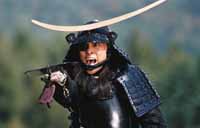
| They started with the slogan, "We can match the movies!" NHK's Annual Historical Dramas, now in their 43rd year, are set in a wide variety of periods and places. They are also now shown using the fine image and sound quality of Hi-Vision (HDTV), with data broadcasting also adding to the viewing pleasure. |
Annual Historical Dramas: 40 years sketching the shape of the nation |
| NHK's first Annual
Historical Drama serial, A Flamboyant Life, began in April 1963, during
the golden age of Japanese cinema. Under the slogan "We can match
the movies!" NHK fought for audience share through the new medium
of television, then sometimes described as "story-telling with electronic
pictures." The first serial featured a number of famous actors, including
Onoe Shoroku, Sata Keiji, Awashima Chikage, Kagawa Kyoko, and Yachigusa
Kaoru. The second serial, Ako-Roshi, had an even more distinguished cast. In the leading role was Hasegawa Kazuo, then at the height of his popularity, with support from Onoe Baiko, Yamada Isuzu and Takizawa Osamu. By featuring top actors from film, kabuki and contemporary theater, NHK's period dramas quickly won a huge public following. The importance of casting was underscored by the third serial, Taikoki. A rising star of contemporary theater, Ogata Ken, took the lead role, with Takahashi Koji, an understudy at Bungakuza Theater, playing Oda Nobunaga, and Ishizaka Koji, a student at Keio University, taking the role of Ishida Mitsunari. A key scene in a big battle was shot from a helicopter, opening up new horizons for TV drama. Ako-Roshi achieved an average 31.9% audience share and Taikoki 31.2%. And so, by as early as the third serial, NHK's Annual Historical Dramas had established themselves as a Sunday evening fixture. Up to and including the 15th serial, Kashin, the leading characters were mainly samurai warriors and feudal lords, but Golden Days marked a significant departure. The main character was the merchant Ruson Sukezaemon, and the story focused on Japan's early encounters with the outside world as seen through the lives of ordinary people instead of the ruling establishment. |
The Age of Lions in 1980 marked another
first. Based on an original script for the first time, it was the first
drama of its kind to focus on the Meiji era (late 19th century), when
Japan was opening up to the world. Burning Mountains and Rivers (1984),
Spring Waves (1985) and Life (1986) formed a trilogy about the coming
of the modern age, and ushered in a new phase.
|

